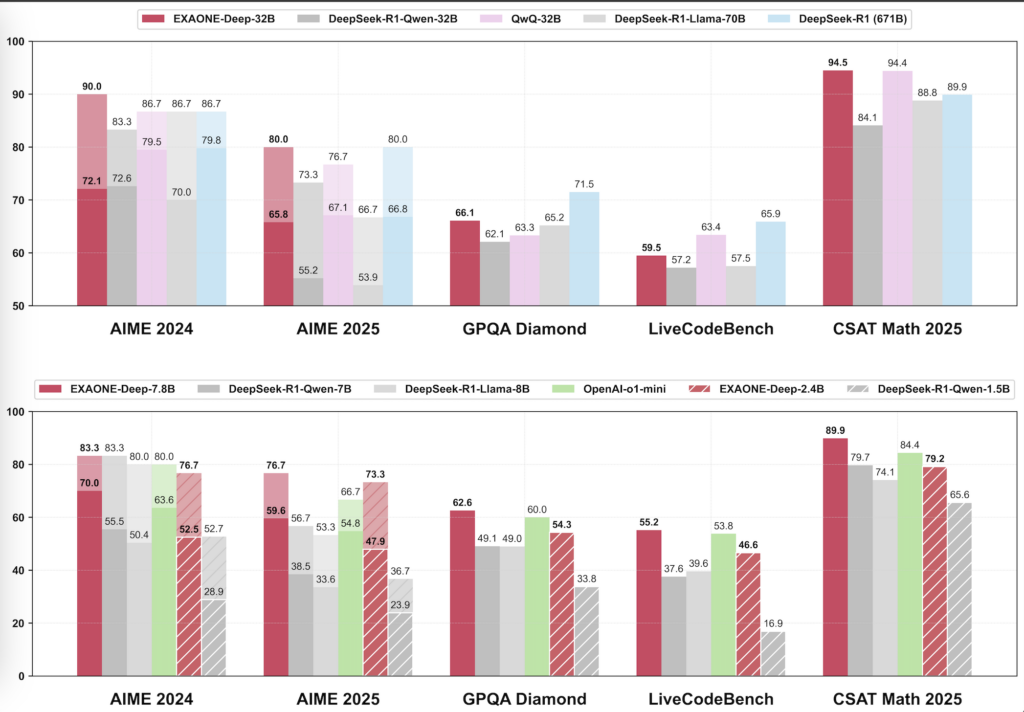EXAONE Deep is a series of advanced large language models introduced by LG AI Research March 18, 2025. It is designed specifically to excel at complex reasoning tasks (e.g. mathematics, science, and coding), while using relatively efficient model sizes. The lineup includes models with 2.4B, 7.8B, and 32B parameters, all openly released for research, showcasing Korea’s competitiveness in AI on the global stage. Below is a breakdown of EXAONE Deep’s purpose, features, technology, and its relevance in industry and real-world use cases.
Purpose and Background
EXAONE Deep was developed to push the boundaries of “reasoning AI” – moving beyond simple knowledge retrieval to active problem-solving and logical reasoning. LG AI Research’s goal was to create a model that can formulate and test hypotheses autonomously, heralding what it calls the era of “Agentic AI” (AI systems that make independent decisions through reasoning). By focusing on math, scientific, and coding challenges, EXAONE Deep aims to set a new standard for AI’s reasoning capabilities in both professional and everyday contexts. Its release as an open-source model was a strategic move to demonstrate Korea’s AI advancements globally and to encourage broader research collaboration.

Key Features and Technology
- Reasoning-Optimized Models: EXAONE Deep models are fine-tuned for complex reasoning tasks. They were trained on a specialized dataset incorporating extended “chain-of-thought” processes, meaning the models learned from long step-by-step reasoning examples rather than just question-answer pairs. This training approach helps the AI break down problems and produce well-founded answers.
- Superior Performance: Despite relatively modest sizes, the models exhibit state-of-the-art performance on reasoning benchmarks. For example, the flagship EXAONE Deep-32B achieved top-tier scores on difficult math and science evaluations – scoring 94.5 on a national math exam (2025 CSAT) and 95.7 on a challenging math problem set (MATH-500). It also demonstrated doctoral-level scientific reasoning, with high marks in physics, chemistry, and biology problems. In coding tests, EXAONE Deep-32B reached 59.5 on the LiveCodeBench (a coding ability benchmark), indicating strong problem-solving for programming tasks.
- Efficiency and Scale: A notable feature is the models’ high efficiency relative to size. The 32B model operates at about 5% of the size of certain massive AI models, yet delivers comparable reasoning performance. In fact, LG’s 32B model was highlighted for achieving “world-class performance with a remarkably small parameter size.” Two smaller variants were released alongside it: EXAONE Deep-7.8B (about 24% the size of the 32B) and EXAONE Deep-2.4B (about 7.5% the size). Impressively, the 7.8B “lightweight” model retains roughly 95% of the 32B’s performance, and the 2.4B “on-device” model retains about 86%. This means even the compact models perform nearly as well as the largest model, offering practicality for limited hardware.
- Open and Accessible: All EXAONE Deep models were released open-source (e.g. via Hugging Face), underlining a commitment to transparency and collaboration. Researchers and developers can freely download and experiment with the 2.4B, 7.8B, and 32B models, which encourages community-driven improvements and a wide range of experimental applications. This open availability is coupled with detailed performance evaluations published by LG, so users can benchmark the models’ reasoning skills against other AI systems.
Applications and Use Cases
EXAONE Deep’s strong reasoning abilities open up numerous applications across different fields:
- Advanced Mathematics & Education: The model can solve complex math problems and even excel in exam-style questions. For instance, EXAONE Deep-32B’s high score on the CSAT and MATH-500 benchmarks suggests it could serve as a tutoring aid or problem-solving assistant for advanced math education. It can help students or researchers work through challenging calculations and proofs step-by-step.
- Scientific Research Assistance: With demonstrated performance at doctoral-level scientific reasoning in physics, chemistry, and biology, EXAONE Deep can act as an AI research assistant. It is capable of understanding scientific questions, forming logical hypotheses, and suggesting solutions in complex domains. This makes it valuable for scientists and engineers who want help in exploring theoretical problems or analyzing experimental data.
- Coding and Software Development: EXAONE Deep showed competitive results on coding benchmarks, indicating it can assist in programming tasks. Developers might use it for code generation, debugging, or logic planning. For example, given a problem description, the model could generate code snippets or outline an algorithmic approach, making it a powerful tool for software development and teaching programming concepts.
- On-Device AI Applications: The smallest model (2.4B parameters) is designed for on-device use, retaining strong performance while being lightweight. This enables integration into devices like smartphones, automobiles, and robots without needing constant cloud connectivity. Such on-device AI can power smart features (like personal assistants or intelligent control systems) while keeping data local for privacy. Industries are expected to leverage this for secure and fast AI processing in embedded systems.
- Industry and Enterprise Solutions: Beyond specialized tasks, EXAONE Deep is poised to be used in various professional fields. Its robust reasoning can support decision-making in business, finance, or law by analyzing complex scenarios and providing well-reasoned answers. LG AI Research specifically anticipates the model to be useful in future industry applications that require logic and problem-solving, as well as in educational tools across STEM fields.
Industry Relevance and Impact
EXAONE Deep’s launch is significant for the AI industry and highlights several important trends:
- Milestone for AI in Korea: LG’s development of EXAONE Deep marks the first time a Korean-built foundation model achieved leading reasoning performance on a global stage. Unveiled at NVIDIA’s GTC conference and released globally, it demonstrates that top-tier AI innovation is not limited to a few US-based or Chinese tech giants. This has elevated Korea’s profile in AI, showing that local research can compete with the world’s best in AI reasoning.
- Setting a New Standard: With its combination of high reasoning ability and efficiency, EXAONE Deep is seen as setting a new benchmark for AI models. By achieving strong results with a smaller model, it challenges the industry to pursue more optimal, resource-efficient AI. This is especially relevant as companies seek powerful AI solutions that can run with lower computational cost.
- Recognition and Open Collaboration: The EXAONE Deep-32B model was recognized by external AI experts, being listed among “Notable AI Models” by the non-profit Epoch AI upon its open-source release. Such recognition underscores its technological significance. Moreover, the decision to open-source the model fosters industry-wide collaboration. Companies, startups, and researchers can build upon EXAONE Deep for their own applications, accelerating innovation in areas like reasoning-based AI agents, education platforms, and expert systems.
- Practical Deployment & Ecosystem Integration: LG has emphasized that reducing model size while maintaining performance is key to practical AI. The efficient design of EXAONE Deep means it can be deployed in real-world products sooner. In fact, LG plans to integrate EXAONE Deep models into its own products and services – from smart home appliances and smartphones to automotive AI systems – through its affiliates like LG Electronics and LG U+. This vertical integration strategy indicates a direct path from the AI research lab to consumer and industry applications, potentially resulting in new AI-driven features in everyday devices.
Notable Advancements and Outlook
Looking forward, the use cases of EXAONE Deep are expected to grow as the model is adopted and fine-tuned for specific tasks. LG AI Research projects high utilization in scientific research, education, and various industries given the model’s strong performance in math, science, and coding domains. Early adoption in Korea’s tech ecosystem may pave the way for global use, especially since the models are publicly available. In summary, EXAONE Deep serves as a powerful and flexible reasoning engine, illustrating how AI can be applied to solve complex real-world problems while pushing the industry towards more efficient AI solutions.

International SEO Consultant (Freelance)
Founder of Kelogs, a SaaS SEO Crawler & Log Analyzer
Over 15 years of SEO experience
Read more about me, myself and I.
